St. Paulinus of Nola
Scroll for quotes→
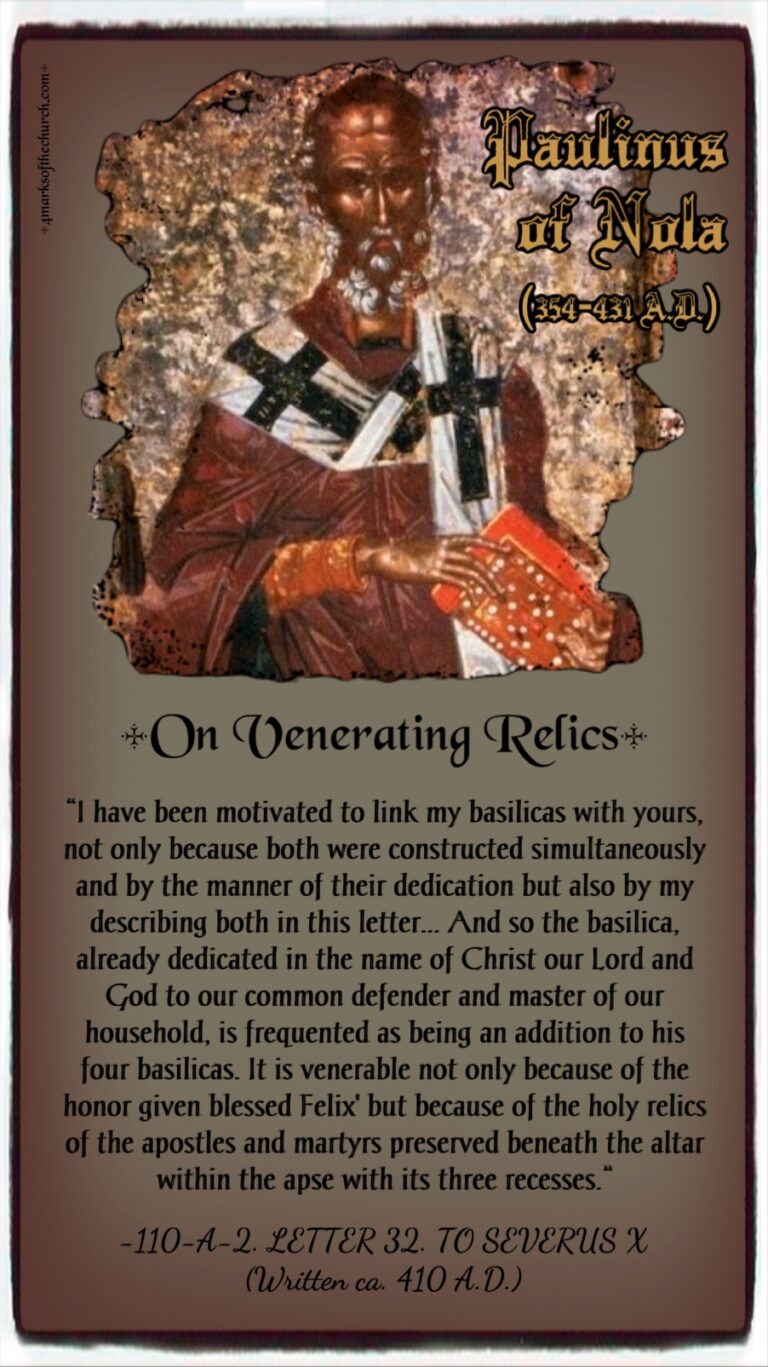
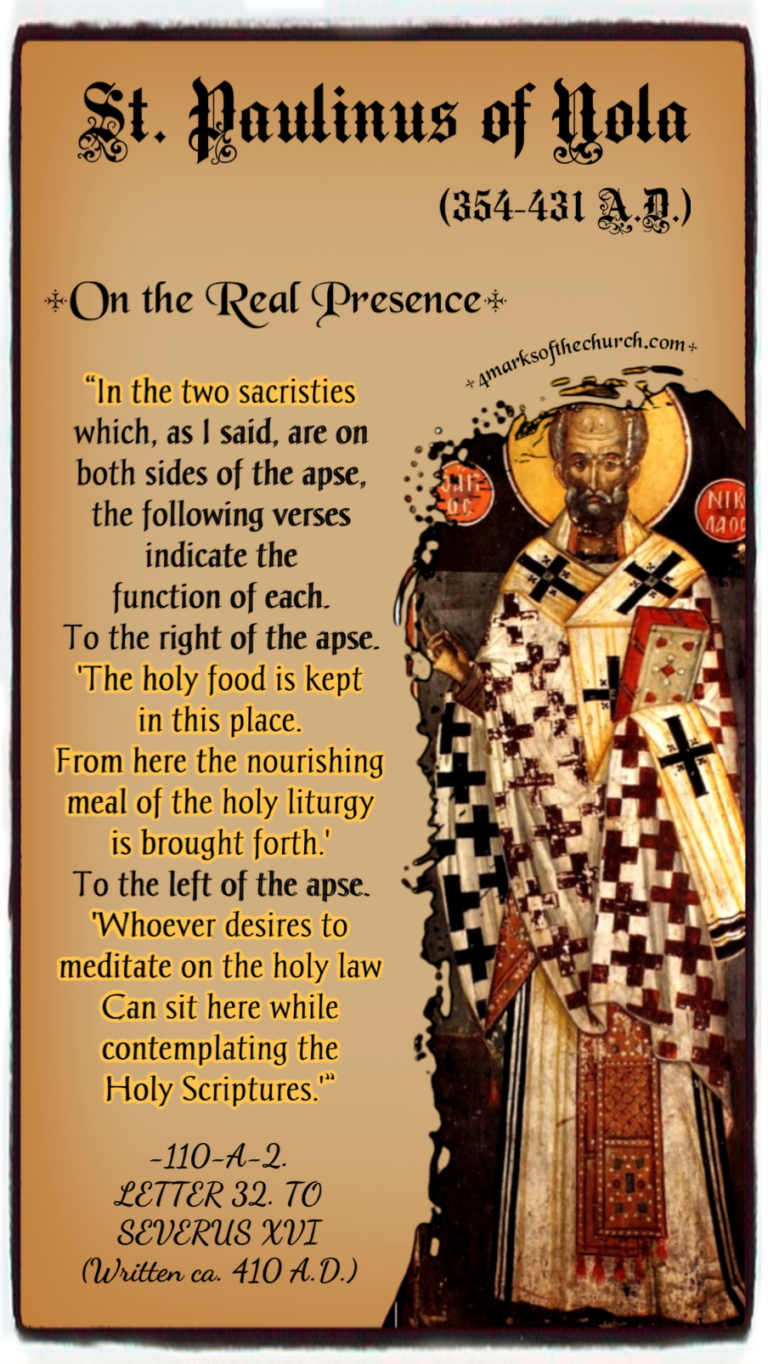
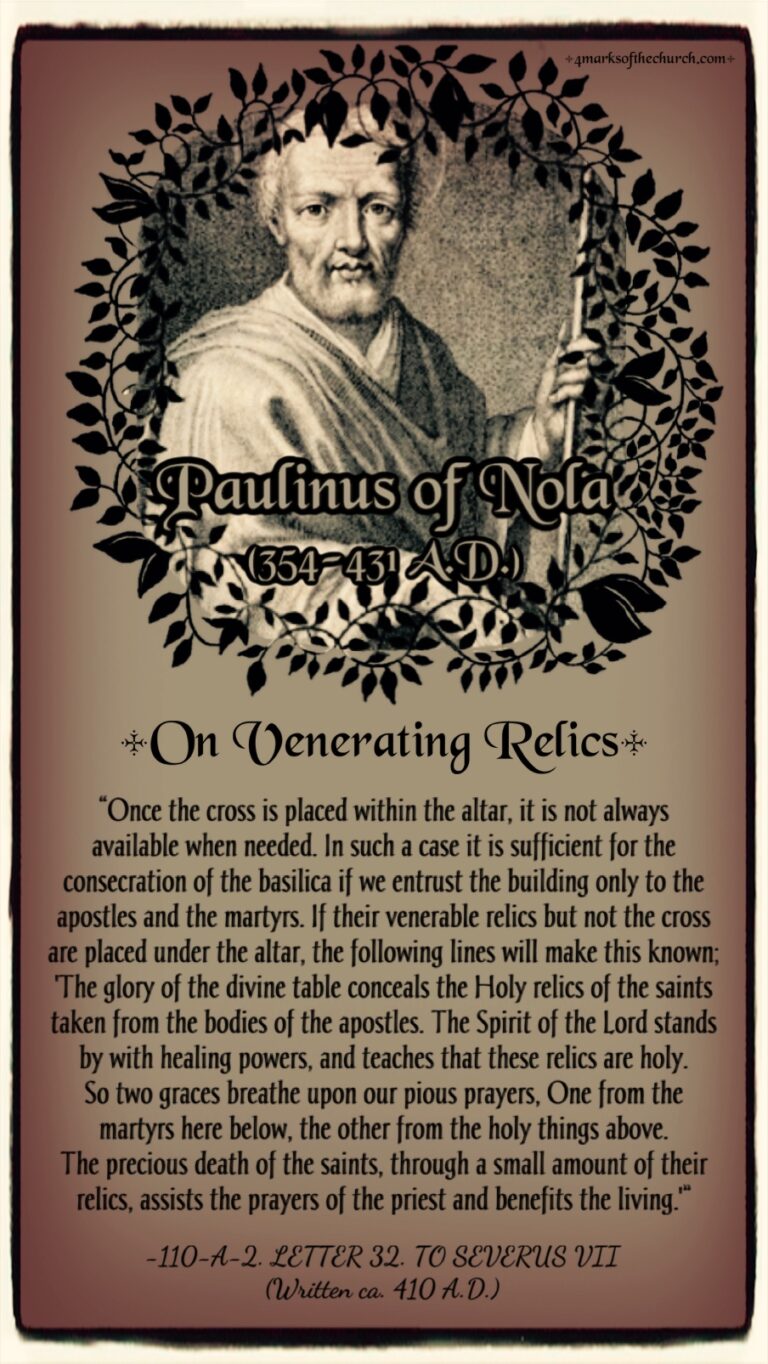
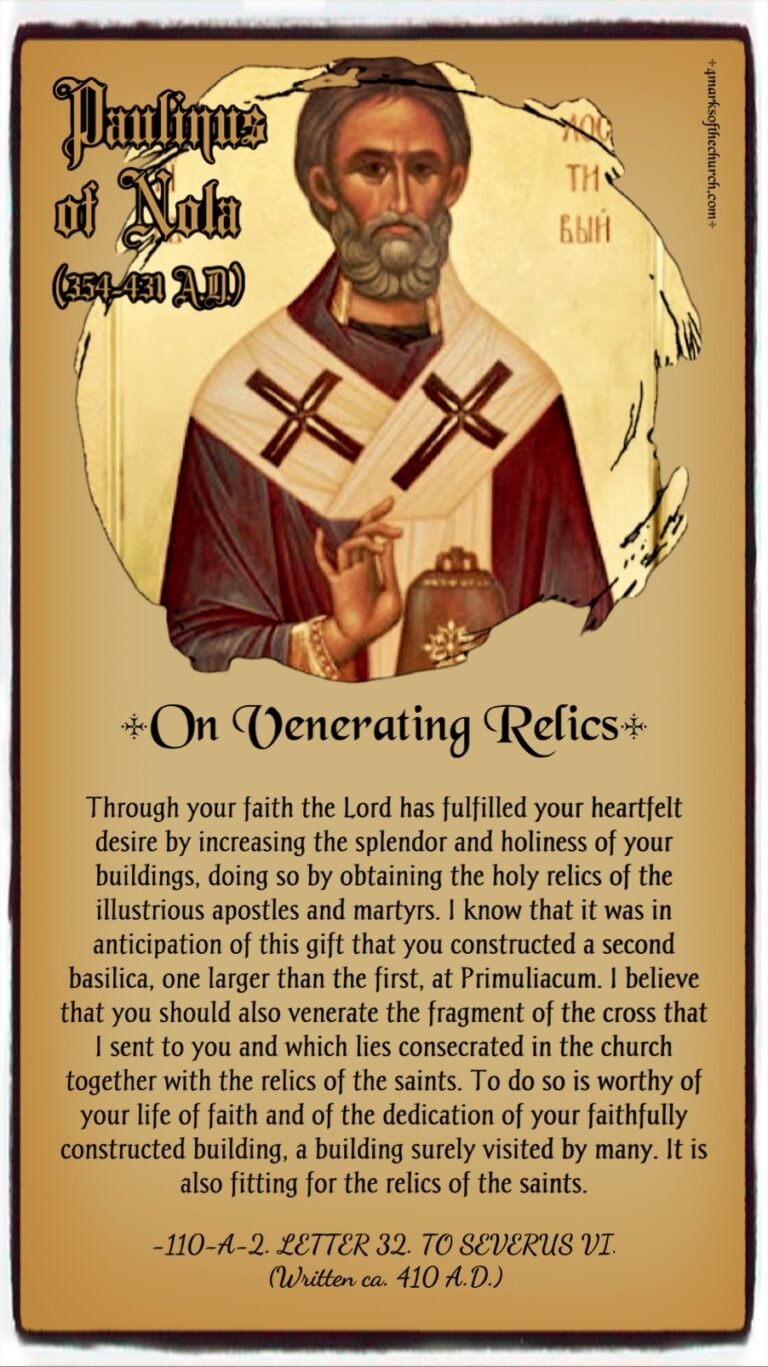
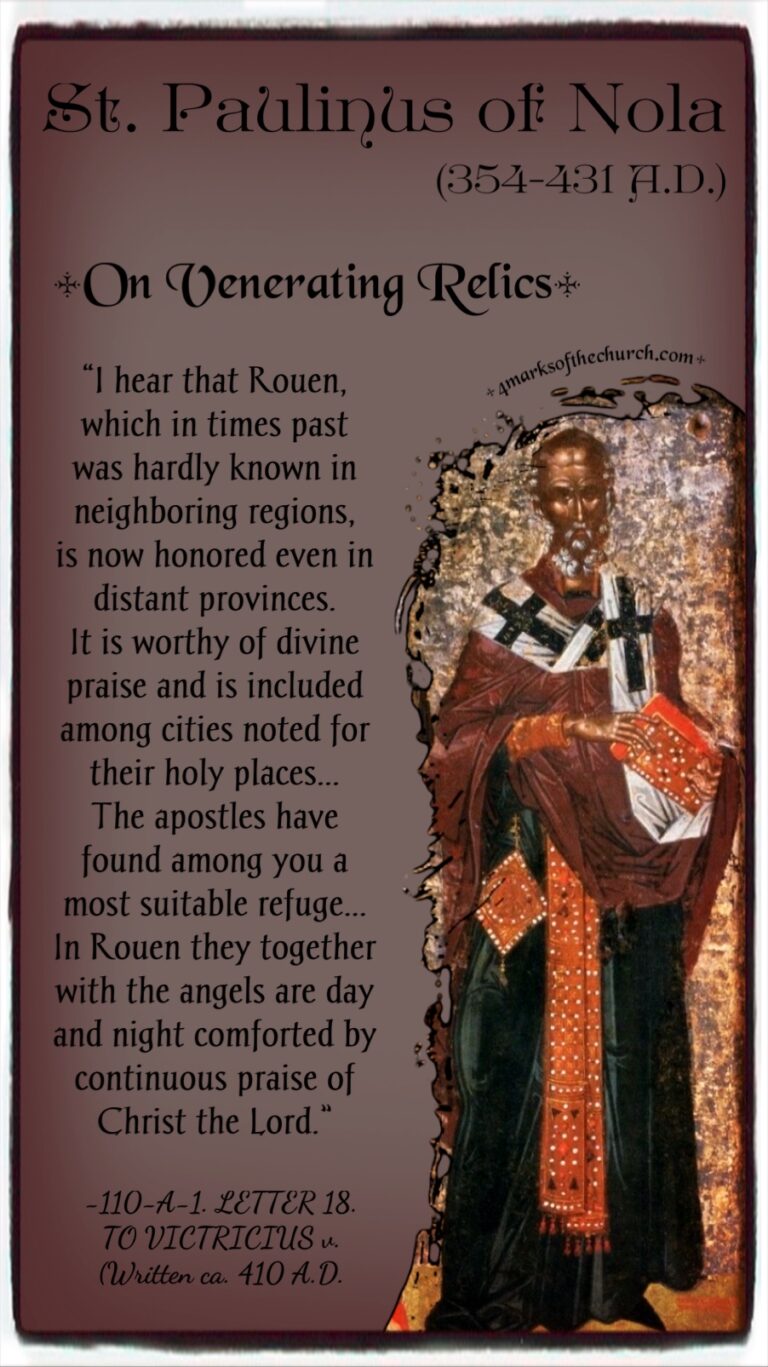
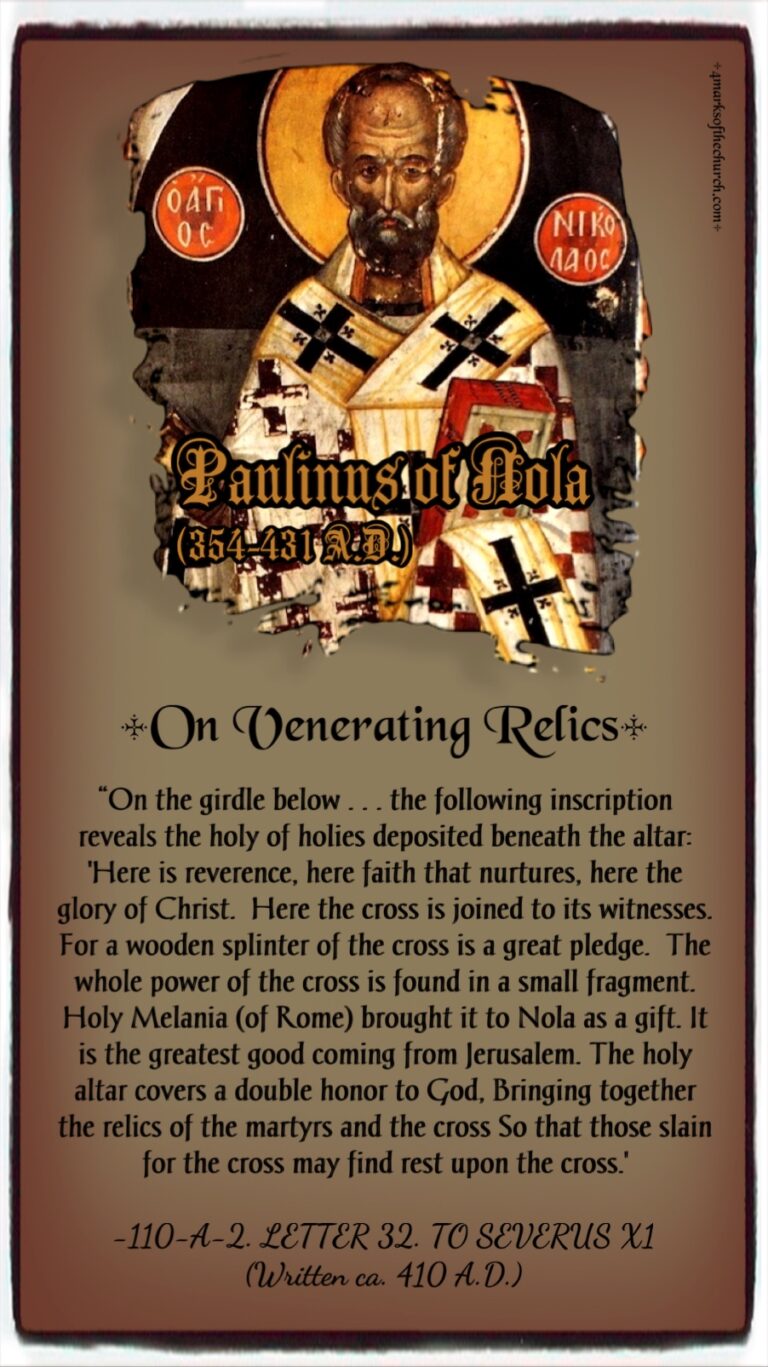
Paulinus of Nola (354-431 A.D.) born Pontius Meropius Anicius Paulinus, is credited with the introduction of bells to Christian worship and helped resolve the disputed election of Pope Boniface I. Born to a wealthy family and even serving in the senate at Rome, he eventually withdrew from the world, giving away all his possessions. His renunciation of his wealth and station in favor of an ascetic and philanthropic life was held up as an example by many of his contemporaries—including St. Augustine, St. Jerome, St. Martin of Tours, and St. Ambrose—and he himself was subsequently venerated as a saint. His relics became a focus of pilgrimage, but were removed from Nola sometime between the 11th and 20th centuries. Paulinus was named Bishop of Nola in 409 A.D. and engaged in widespread correspondence with many church leaders including those named above. Although not highly theological, they impart much information as to the religious life of people during his time.
Writings:
- Letters
return to top ⇑
Quotes and Excerpts:
-WORSHIP IN THE EARLY CHURCH. An Anthology of Historical Sources. Volumes 1-4 Lawrence J. Johnson. A PUEBLO BOOK. Liturgical Press Collegeville, Minnesota
110-A-1. LETTER 18. TO VICTRICIUS
v. I hear that Rouen, which in times past was hardly known in neighboring regions, is now honored even in distant provinces. It is worthy of divine praise and is included among cities noted for their holy places… The apostles have found among you a most suitable refuge… In Rouen they together with the angels are day and night comforted by continuous praise of Christ the Lord. .. In Rouen they take great delight in the most pure hearts and voices of your sheep and in the daily unity of those who sing with true understanding’ in the town’s populous churches and more secluded monasteries.
110-A-2. LETTER 32. TO SEVERUS
VI. Through your faith the Lord has fulfilled your heartfelt desire by increasing the splendor and holiness of your buildings, doing so by obtaining the holy relics of the illustrious apostles and martyrs. I know that it was in anticipation of this gift that you constructed a second basilica, one larger than the first, at Primuliacum. I believe that you should also venerate the fragment of the cross that I sent to you and which lies consecrated in the church together with the relics of the saints. To do so is worthy of your life of faith and of the dedication of your faithfully constructed building, a building surely visited by many. It is also fitting for the relics of the saints. Should it please you, the following verses will make known your decision.
‘The holy altar conceals a divine union.
Martyrs together with the holy cross are placed here.
The whole martyrdom of Christ the Savior is gathered here, The cross, the body, the blood, the martyr, Divinity itself.
God always preserves the divine gifts for you.
Where Christ is, there the Spirit and the Father are.
Thus where the cross is, so too is the martyr because
The martyr’s cross is the holy reason for the saint’s martyrdom.
Where the cross has given us the food of life, it has given a crown
Whereby his servants share in the Lord.
The flesh that I eat is nailed to the cross.
His blood, by which I drink life and wash my heart, flows from the cross.’
VIL. Perhaps you prefer that this blessing from the cross be readily available for your daily protection and healing. Once the cross is placed within the altar, it is not always available when needed. In such a case it is sufficient for the consecration of the basilica if we entrust the building only to the apostles and the martyrs. If their venerable relics but not the cross are placed under the altar, the following lines will make this known.
‘The glory of the divine table conceals the Holy relics of the saints taken from the bodies of the apostles.
The Spirit of the Lord stands by with healing powers, and teaches that these relics are holy.
So two graces breathe upon our pious prayers,
One from the martyrs here below, the other from the holy things above.
The precious death of the saints, through a small amount of their relics,
Assists the prayers of the priest and benefits the living.’
X. […] I have been motivated to link my basilicas with yours, not only because both were constructed simultaneously and by the manner of their dedication but also by my describing both in this letter… And so the basilica, already dedicated in the name of Christ our Lord and God to our common defender and master of our household, is frequented as being an addition to his four basilicas. It is venerable not only because of the honor given blessed Felix’ but because of the holy relics of the apostles and martyrs preserved beneath the altar within the apse with its three recesses. The apse, having a floor and marble walls, is illuminated by a vault decorated with mosaics, whose painting contains the following verses.
‘The Trinity glows in its full mystery.
Christ is pictured as a lamb;
the Father’s voice resounds from heaven.
The Holy Spirit flows down in the form of a dove.
The cross is surrounded by a wreath, by a bright circle,
Around which the apostles form a wreath,
Whose image is represented by a choir of doves.
The holy unity of the Trinity meets in Christ, With the Trinity having its proper symbols.
The Father’s voice and the Spirit reveal God.
The cross and the lamb confess the holy victim.
The purple and the palm point to the kingdom and to triumph.
Christ, the Rock of the Church, stands upon a rock.
From this rock flow four bubbling springs, The evangelists, the living streams of Christ.’
x1. On the girdle below . .. the following inscription reveals the holy of holies deposited beneath the altar.
‘Here is reverence, here faith that nurtures, here the glory of Christ.
Here the cross is joined to its witnesses.
For a wooden splinter of the cross is a great pledge.
The whole power of the cross is found in a small fragment.
Holy Melania (of Rome) brought it to Nola as a gift.
It is the greatest good coming from Jerusalem.
The holy altar covers a double honor to God, Bringing together the relics of the martyrs and the cross
So that those slain for the cross may find rest upon the cross.’
XI1. The space outside the basilica’s apse extends under a high paneled ceiling. On each side there are double colonnades. Four rooms within each colonnade are located within the basilica’s side walls. These rooms are for the benefit of those desiring to pray privately or to meditate on the Lord’s law. They also serve as places where the clergy and their associates may obtain eternal rest. Each room is marked by verses, which I will not reproduce in this letter. I have, however, written down the verses that appear over the basilica’s entrances because, if you desire to use them, they may be appropriate for the doors of your basilicas. Such would be the following.
‘Peace to all of you who are entering the house of God, pure and with peaceful hearts.’
Or the following which describes the holy picture of the Lord above the entrance.
‘Look upon the wreathed cross of Christ the Lord that is located above the narthex.
It promises great rewards for hard labor.
Take up your cross if you wish to carry away the wreath.’
In the second basilica the following verses appear over the more private door which one passes through when entering in a private way from the little garden or orchard.
‘O worshipers of Christ, through pleasant greenery enter the way toward heaven.
It is most fitting to approach from this joyful garden.
From here holy paradise is granted to those who merit it.’
The same door is marked with other verses within.
“You leave the Lord’s house after completing your prayers,
Return in body but remain in heart.’
NIl. Contrary to custom, the basilica faces not the east but toward the basilica of my blessed Lord Felix, namely, toward his tomb. The apse curves its way around with side apses on both the right and the left in the open space. One of these apses can be used by the bishop when offering the sacrifice of joy (the Mass); the other in a large curve holds the numerous people at prayer behind the priest. The whole area faces the basilica of our venerated confessor, giving joy to one’s sight, with three equal arches and with the light shining through the grating connecting the roofs and walkways of each basilica.
Because the intervening wall of the apse of a tomb would separate the old church from the new church, the wall on the side of blessed Felix’s church contains as many doors as are at the side of the new church’s front entrance. Through the wall one can look into the other church. And so these verses appear at the entrances of the new church.
‘This loving house lies open to those who enter through the triple arch.
This three-fold door is a witness to their devout faith.’
XIv. Likewise on the right and left of this, next to crosses painted red, are these lines.
‘The cross is enriched with a laurel of flowers.
It is red with the blood shed by our Lord.
The doves sitting above this divine symbol
Show that God’s kingdom lies open to the simple.’
[And another.]
‘By means of this cross remove us from the world and the world from us.
Give life to our souls by destroying our sins.
If your peace flourishes in our pure hearts, You will make us also your favored doves.’
XVI. In the two sacristies which, as I said, are on both sides of the apse, the following verses indicate the function of each.
To the right of the apse.
‘The holy food is kept in this place.
From here the nourishing meal of the holy liturgy is brought forth.’
To the left of the apse.
‘Whoever desires to meditate on the holy law
Can sit here while contemplating the Holy Scriptures.’
return to top ⇑